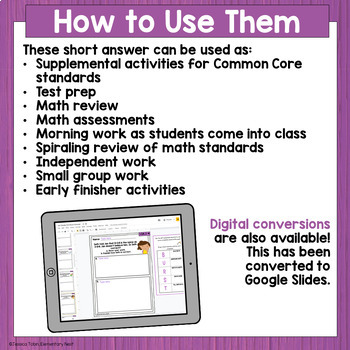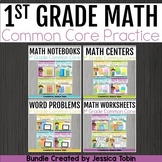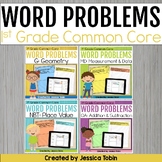1st Grade Math Word Problems - 1.OA Addition and Subtraction Short Answer
- PDF
- Google Apps™

Also included in
- This is a common core aligned math bundle for 1st grade. There are four bundles included: worksheets, centers, short answer or word problems, and interactive notebook templates. Each packet included standard-specific activities. There are centers, printables, short answer, and interactive notebook tPrice $64.00Original Price $91.00Save $27.00
- This math word problems bundle is a short answer response 1st grade practice resource to use when teaching common core math! This is not a curriculum, but a resource to help supplement your lessons! There are between 2 and 5 short answers PER standard to practice towards the end of a unit or beforePrice $14.00Original Price $18.00Save $4.00
Description
This 1st grade math word problem pack covers the Operations and Algebraic Thinking standards, which are all about word problems and addition and subtraction strategies! There are short answer questions for topics such as word problems, subtraction fluency, addition fluency, and more! This is perfect to use when teaching students how to answer constructed response questions.
In this pack, you are able to choose the format that you would like to use for your students.
- traditional worksheets
- cut-and-glue strips for a notebook
- digital slides (Google)
This item aligns with the Common Core standards for the Operations and Algebraic Thinking domain, but you don't have to be in a Common Core classroom to use this pack!
Operations and Algebraic Thinking Topics Covered:
- Word Problems to 10
- Word Problems to 20
- Adding 3 Numbers
- Addition and Subtraction Strategies
- Addition and Subtraction Fluency
- Using Counting to Add and Subtract
- Unknown Addends
- Equal Sign
There is also a word problem strategy page at the beginning. One is a poster to print and keep in your classroom. The other are small bookmarks for students to hold onto while they are learning.
This item is included in a money-saving word problem short answer bundle.
You can also save even MORE money by buying this pack within the First Grade Common Core Math Mega Bundle!
Not interested in buying bundles? But still want 1st grade Addition and Subtraction Strategies products?
- Click here for OA printables.
- Click here for OA centers.
- Click here for OA interactive notebook activities.
Like this resource? Make sure to follow my store to keep up with brand-new products!
This purchase is for one single classroom only.
If you're interested in sharing with other classrooms, make sure to buy the extra licenses for a discount through the TeachersPayTeachers tool. If you are interested in a site license, please contact me for a quote at jessica.L.tobin@gmail.com.
Standards Covered:
- CCSS.Math.Content.1.OA.A.1 (1.OA.1)- Use addition and subtraction within 20 to solve word problems involving situations of adding to, taking from, putting together, taking apart, and comparing, with unknowns in all positions, e.g., by using objects, drawings, and equations with a symbol for the unknown number to represent the problem.
- CCSS.Math.Content.1.OA.A.2 (1.OA.2)- Solve word problems that call for addition of three whole numbers whose sum is less than or equal to 20, e.g., by using objects, drawings, and equations with a symbol for the unknown number to represent the problem.
- CCSS.Math.Content.1.OA.B.3 (1.OA.3)- Apply properties of operations as strategies to add and subtract. Examples: If 8 + 3 = 11 is known, then 3 + 8 = 11 is also known. (Commutative property of addition.) To add 2 + 6 + 4, the second two numbers can be added to make a ten, so 2 + 6 + 4 = 2 + 10 = 12. (Associative property of addition.)
- CCSS.Math.Content.1.OA.B.4 (1.OA.4)- Understand subtraction as an unknown-addend problem. For example, subtract 10 - 8 by finding the number that makes 10 when added to 8.
- CCSS.Math.Content.1.OA.C.5 (1.OA.5)- Relate counting to addition and subtraction (e.g., by counting on 2 to add 2).
- CCSS.Math.Content.1.OA.C.6 (1.OA.6)- Add and subtract within 20, demonstrating fluency for addition and subtraction within 10. Use strategies such as counting on; making ten (e.g., 8 + 6 = 8 + 2 + 4 = 10 + 4 = 14); decomposing a number leading to a ten (e.g., 13 - 4 = 13 - 3 - 1 = 10 - 1 = 9); using the relationship between addition and subtraction (e.g., knowing that 8 + 4 = 12, one knows 12 - 8 = 4); and creating equivalent but easier or known sums (e.g., adding 6 + 7 by creating the known equivalent 6 + 6 + 1 = 12 + 1 = 13).
- CCSS.Math.Content.1.OA.D.7 (1.OA7)- Understand the meaning of the equal sign, and determine if equations involving addition and subtraction are true or false. For example, which of the following equations are true and which are false? 6 = 6, 7 = 8 - 1, 5 + 2 = 2 + 5, 4 + 1 = 5 + 2.
- CCSS.Math.Content.1.OA.D.8 (1.OA.8)- Determine the unknown whole number in an addition or subtraction equation relating three whole numbers. For example, determine the unknown number that makes the equation true in each of the equations 8 + ? = 11, 5 = _ - 3, 6 + 6 = _.







